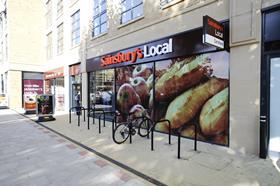
The convenience channel stands to grow by a sizeable 30 per cent over the next five years, according to the IGD, with fruit and vegetable sales set to play a major part.
The trend away from big weekly or even monthly shops towards more ‘little and often’ trips is giving a real boost to the convenience store segment, with small shops, fascias and multiples all competing in that space. And with shoppers largely considered willing to spend more in a c-store, does that mean further opportunity for added-value fruit and vegetable brands?
Top-up shopping remains the primary motivator for c-store visits, IGD research suggests, and buying fruit and vegetables is fourth on the list. Some 25 per cent of people go to a c-store to buy fresh produce. That figure is the same for both visits to multiples and co-operatives, though when it comes to symbols, independents and forecourts, fruit and vegetables do not figure in the top five reasons for visiting.
That would suggest that the ‘small supermarket’ concept of stores such as Tesco Express, Sainsbury’s Local and The Co-operative is the place where fresh produce marketers should be targeting their brands. The opportunity is only underlined by the Association of Convenience Stores’ 2014 Local Shop Report, which marks fruit and vegetables as the fastest-growing category at 8.4 per cent.
“If you have a trusted brand within the main estate and are able to adapt your product, without compromising on quality, the convenience market can be successful for brands,” says Albert Bartlett’s marketing executive Anne Rodgers.
To succeed, branding experts agree that pack size is crucial. “Pack size must be right for this market as shoppers are buying a smaller volume less frequently,” adds Rodgers. “You must maintain the same quality for products in these stores. We feature recipes from brand ambassadors Michel Roux Jr and Andrew Fairlie on our packaging, also meaning the shopper is presented with different ideas at the fixture.”
The importance of the pack is echoed by Michelle Toft, chief marketing officer at Pink Lady and Tenderstem licensor Coregeo. “The reputation of the brand will be taken into account, along with its proven success in the major stores,” she explains. “We know that for our brands, the convenience shopper is our ideal customer. We know that both brands offer solutions (snack and recipe), so we need to make sure that we are offering the right pack with the right information.”
There certainly seems to be the opportunity to get more fruit and vegetable lines generally, and brands in particular, into c-stores. IGD’s ShopperVista Channel Focus shows that, of 10 categories analysed from snacks to lottery tickets, alcohol and tobacco, topping up on fruit and vegetables is the area with the most potential for further growth. While 25 per cent of c-store shoppers currently use them for topping up on fruit and veg, a further 45 per cent would consider doing so. Only 30 per cent said they would not use the stores for that purpose.
“Given the trend for shoppers to purchase groceries more frequently, c-stores are in line with current consumer behaviour and are, as a result, performing well,” says Sandy Sewell, commercial director at Florette. “Florette is echoing this trend by having a +17 per cent share in c-stores, versus the overall market share of +12 per cent [Nielsen, 4 w/e 31 January]. People go in looking for salad and buy salad. The reassurance of the Florette brand helps to encourage shoppers to buy our products.”
Florette is one of the only fresh produce brands to have listings in the majority of c-stores, and Sewell believes that while stores are always likely to give more exposure to brands in the face of reduced shelf space, products still have to justify their position based on sales performance and consumer need.
Crucially, while better-quality produce is the top priority named by shoppers in the IGD’s survey (40 per cent), brand name (33 per cent) is the third-most important factor, aside from price, that consumers are concerned about.
That would seem to open the door to brands to make their mark. And though price is still the main consideration for shoppers, there is a general understanding that there are good opportunities for added-value lines in c-stores, according to Mark O’Sullivan, MD of BanaBay.
“Consumers expect to pay more in convenience stores anyway as they understand the principle of low prices flowing from massive purchasing power and pressure by supermarkets on suppliers,” he says. “But over and above this, we believe the emerging purchasing patterns of ‘little and often’ over bulk buying reflects not only a change in lifestyle and convenience shopping, but also a preference for buying produce that is regarded as truly ‘fresh’.
“Purchasing food for only a few days ahead also generates a series of smaller bills, rather than one very large bill, so the consumer feels less of an impact at the till. All these influences mitigate towards purchase of premium brand produce rather than cheaper own-label alternatives.”
It is still tough to win shelf space in small-format stores, but for those that do, there is the chance to grow alongside a rapidly-expanding sector.






No comments yet